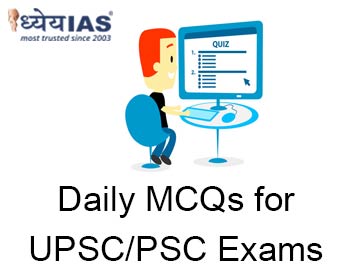Home > Daily-mcqs
Daily-mcqs 19 Jun 2025

Q1:
How many of the following statements about the SEEDS initiative are correct? 1. It is implemented by NABARD directly. 2. It supports SMEs in partner countries. 3. It involves both financial and technical assistance. 4. It is focused only on South Asia. Options:
A: Only 1
B: Only 2
C: Only 3
D: All four
Answer: C
Explanation:
Statements 2 and 3 are correct – SEEDS supports SMEs and includes both grants and technical support. Statement 1 is correct as NABARD is implementing it through its subsidiary NABCONs. Statement 4 is wrong – the initiative is global, not limited to South Asia. Hence, three statements are correct.
Q2:
With reference to India’s Crocodile Conservation Project, consider the following statements: 1. It was supported by the Food and Agriculture Organization (FAO) of the United Nations. 2. It aimed to conserve all three native species of crocodilians. 3. Odisha was the first state to establish crocodile incubation and rearing centres. How many of the above statements are correct?
A: Only 1
B: Only 2
C: All three
D: None
Answer: C
Explanation:
Statements 1, 2, and 3 are correct. The project was launched in 1975 with FAO support, targeting all three Indian crocodilian species—gharial, saltwater crocodile, and mugger. Odisha pioneered egg incubation and rearing centres that were critical to the programme’s early success.
Q3:
Which one of the following features is not associated with Portulaca bharat?
A: Glandular hairs on stamens
B: Pale-yellow flowers
C: Deep forest habitat
D: Opposite and concave leaves
Answer: C
Explanation:
Portulaca bharat is found in open, rocky, and dry environments — not in dense forests. The other features — pale-yellow flowers, glandular hairs, and opposite concave leaves — are distinguishing botanical traits of this species as documented in the research paper.
Q4:
Which of the following is/are components of watershed management? 1. Afforestation 2. River interlinking 3. Sustainable farming 4. Soil and water conservation
A: 1, 2 and 4 only
B: 1, 3 and 4 only
C: 2 and 4 only
D: All four
Answer: B
Explanation:
Watershed management includes afforestation, sustainable agriculture, and soil and water conservation practices. River interlinking is a large-scale infrastructure project, not typically part of local watershed schemes. Eliminate option 2 to arrive at the right answer.
Q5:
Which of the following best explains why long COVID is a public health concern?
A: It causes rare skin disorders and fevers
B: It leads to immediate death in high-risk individuals
C: It can cause lasting disability, reduce workforce participation, and strain
D: It spreads through airborne particles like seasonal flu
Answer: C
Explanation:
Explanation: Long COVID affects a significant percentage of recovered patients, leading to chronic fatigue, cognitive issues, and respiratory problems. These impair productivity, increase healthcare burdens, and may require long-term care. Unlike acute COVID, it does not spread, but its social and economic effects are serious and long-lasting.
Q6:
How many of the following are true about OSA? 1. It causes lower blood oxygen levels. 2. It is associated with cardiovascular and mental health conditions. 3. It leads to improved productivity when treated. 4. It is more common in colder regions.
A: Only 1
B: Only 2
C: All
D: None
Answer: B
Explanation:
Statements 1 and 2 are correct. OSA causes oxygen dips and is linked to diseases like heart conditions, depression, and neurodegenerative disorders. Statement 3 is irrelevant here—though treatment helps, the article does not mention productivity gains from treatment. Statement 4 is incorrect; the study finds OSA worsens with higher temperatures, not colder climates. Hence, only two of the four statements are correct.
Q7:
Which of the following statements about India’s nuclear forces are correct? 1. India has overtaken Pakistan in the number of nuclear warheads. 2. India has started deploying nuclear warheads on canisterised missiles. 3. India operates a nuclear triad. How many of the above statements are correct?
A: Only 1
B: Only 2
C: All three
D: None
Answer: C
Explanation:
SIPRI confirms that as of January 2025, India has 180 warheads, overtaking Pakistan’s 170. It has begun integrating warheads with canisterised missiles, indicating a shift in doctrine. Additionally, India maintains a nuclear triad—land, air, and sea-based delivery systems—placing it among the few countries with such a capacity.
Q8:
How many of the following statements about SEZ reforms for semiconductors are correct? 1. The minimum land area required for a semiconductor SEZ has been reduced from 50 hectares to 10 hectares. 2. SEZs can now sell products in the domestic market after paying applicable duties. 3. Encumbrance-free land is still strictly required for SEZ approval.
A: Only 1
B: Only 2
C: All three
D: None
Answer: B
Explanation:
Statements 1 and 2 are correct. The land area requirement was reduced to 10 hectares, and SEZ units can now sell products domestically after paying duties. However, Statement 3 is incorrect. The encumbrance-free land condition has been relaxed; the Board of Approval can now approve land even if it’s not fully clear of disputes. This change aims to speed up SEZ approvals.